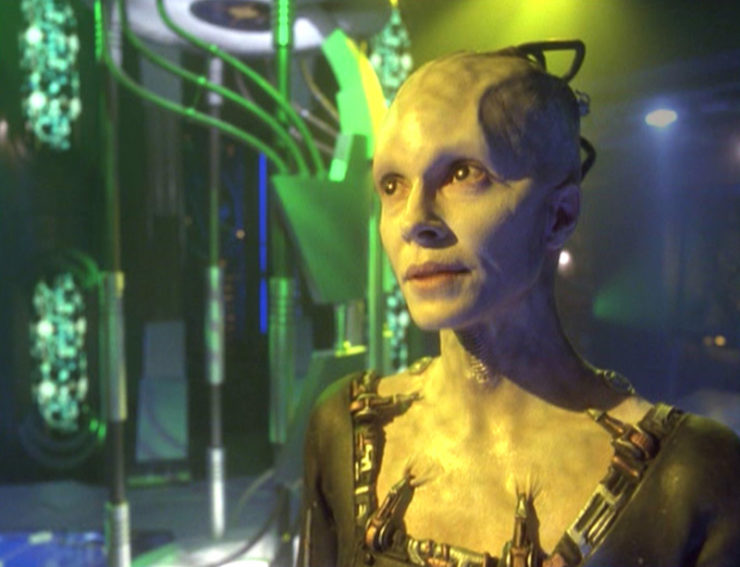“Unimatrix Zero” (Part 1)
Written by Mike Sussman and Brannon Braga & Joe Menosky
Directed by Allan Kroeker
Season 6, Episode 26
Production episode 246
Original air date: May 24, 2000
Stardate: unknown
Captain’s log. On board the unicomplex, the Borg Queen interrogates a drone who is malfunctioning. She asks him about Unimatrix Zero, but the drone doesn’t know what she’s talking about. She separates the drone from the collective, and then deactivates him and orders him dissected.
On Voyager, Seven has a vivid dream while regenerating that she’s in a forest with a bunch of other people of various species, one of whom reaches out to her and calls her, “Annika.” Then she wakes up. She immediately goes to sickbay, thinking this to be some kind of malfunction, but the EMH says that dreaming is a normal part of being human. However, he gives her a device that will measure her REM sleep, just in case.
Buy the Book
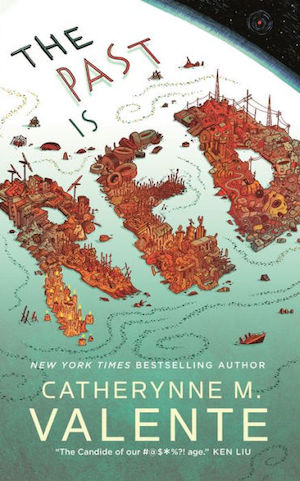

The Past Is Red
When Paris reports for duty, he is informed that his demotion has been reversed, and he’s a junior-grade lieutenant again. Since his duties haven’t changed in the least—he’s still the alpha-shift conn officer and the backup medic—this promotion is particularly pointless.
Voyager responds to a distress call, but arrive too late to save a planet from being destroyed/assimilated by the Borg.
When Seven next regenerates, she’s back in the forest, and the person who called her Annika introduces himself as Axum and says she’s in Unimatrix Zero. This is a virtual-reality setting where a tiny percentage of drones—about one in a million—are able to go and retain their individuality while regenerating. However, they have no memory of the place when they wake up. It turns out that Seven visited there regularly when she was a drone, but this is her first time back since Voyager separated her from the collective.
Seven meets various other folks, including a human woman named Laura who was assimilated at Wolf 359, and a Klingon named Korok. Later, Seven also discovers that she and Axum had a romantic relationship during their regenerative cycles in Unimatrix Zero.
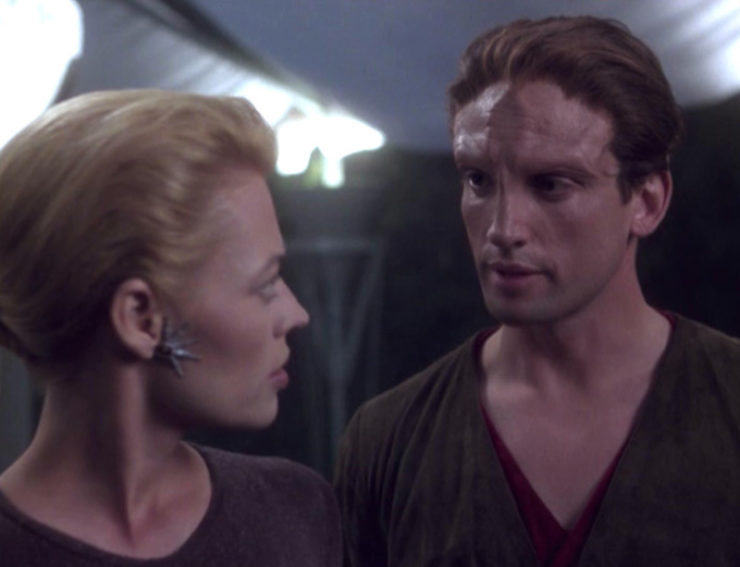
Axum also informs Seven that they need her help: the Borg Queen has discovered the mutation (she calls it a malfunction) that allows Unimatrix Zero to exist, and wants to eliminate it.
When she awakens, Seven reports this to the senior staff. The EMH confirms that it in fact wasn’t a dream—she didn’t achieve REM sleep when she regenerated. Seven likens this to a distress call, and the staff agrees, but Janeway wants more information. Tuvok offers to serve as a telepathic conduit between Seven and Janeway’s minds, allowing Janeway to join Seven when she regenerates in Unimatrix Zero.
Janeway meets Axum and the others, and suggests they try to find a way for the drones to keep their memories of Unimatrix Zero when they wake up. They can form a Borg resistance.
Meantime, the Borg Queen has isolated Unimatrix Zero, and while she can’t destroy it or cut off access to it, she can send drones into it. She does so, and some of the folks in Unimatrix Zero are woken up forcibly, disappearing from the forest. Some of the drones fight back, notably Korok and Janeway. The Borg Queen sees that Janeway is in Unimatrix Zero, and she’s now both pissed and worried.
Upon returning to reality, Janeway instructs Torres and the EMH to create a virus that would allow the drones to retain their individuality upon departing Unimatrix Zero. She also makes sure that Chakotay is with her on this, not willing this time to just barrel ahead without his okay like she did when allying with the Borg and going after Captain Ransom.
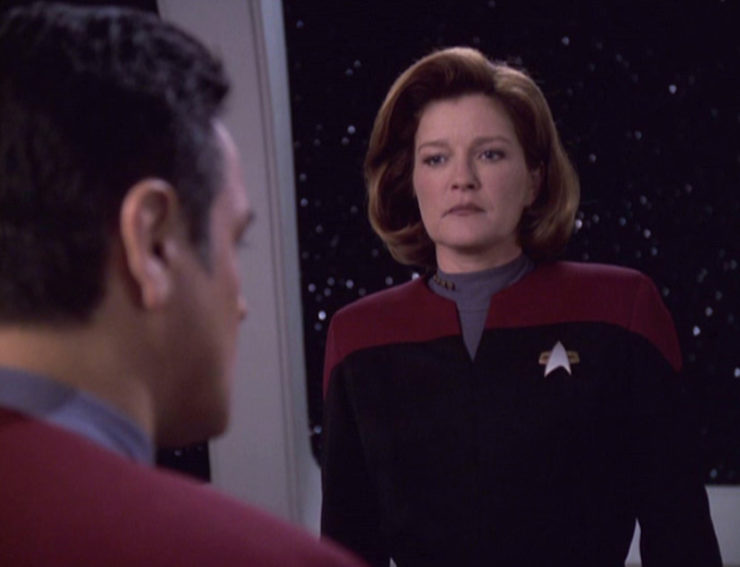
The plan is for Janeway to invade a Cube and upload the virus into the central plexus. Tuvok and Torres insist on accompanying her, Tuvok because of regulations regarding a captain entering hostile territory needing a security guard, Torres because she has the mad engineering skillz needed to upload the virus. Janeway doesn’t want them to come along, but Chakotay insists that his support that she asked for is contingent on his taking the other two with her.
The Borg Queen contacts Voyager and tells Janeway in no uncertain terms to stay the hell out of any involvement with Unimatrix Zero. She even makes noise about offering a faster way home in exchange for staying out of it. Janeway refuses.
Janeway, Torres, and Tuvok take off in the Delta Flyer. Voyager fires on the Cube, and when the shield harmonics fluctuate, the away team beams onto the Cube—just before the Flyer is destroyed by the Borg.
Voyager continues to fire on the Cube while the away team moves through the corridors of the Cube. Eventually, the drones adapt to their phaser fire and trap them in force fields, until they are captured and assimilated.
Once the EMH determines that their life signs are destabilizing, Chakotay orders Voyager to break off.
The last shot is Tuvok, Torres, and Janeway fully Borgified.
To be continued…
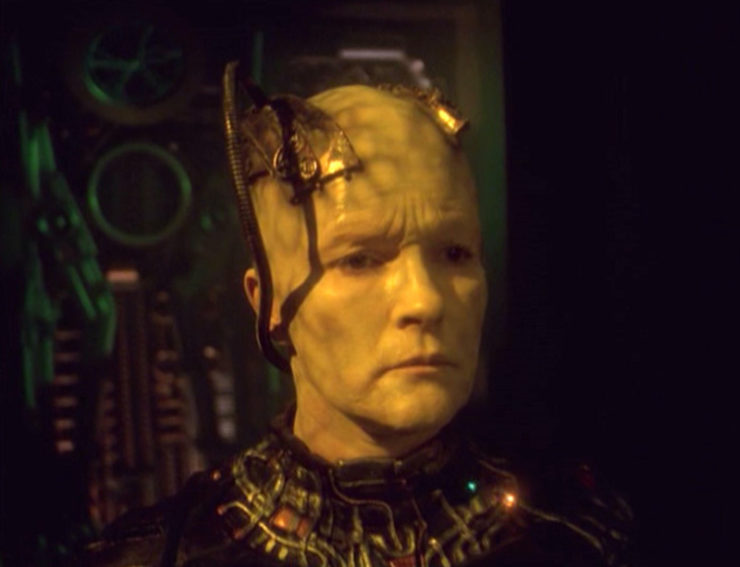
Can’t we just reverse the polarity? Borg Cubes are said to have a central plexus and shield emitters that can be targeted, even though the word on the Borg from the moment we met them in TNG’s “Q Who” was that their technology was completely decentralized.
There’s coffee in that nebula! Janeway says she won’t negotiate with the Borg, which is a big change from two years previous when she did negotiate with them…
Mr. Vulcan. Tuvok gets to be a bridge to mind-melding Seven and Janeway. When asked if he’s ever performed it before by the EMH, Tuvok says no, but he did observe a Vulcan master perfect the technique. I find myself reminded of a bit in the Red Dwarf episode “Bodyswap,” when the android Kryten wants to try to download someone else’s mind into Lister’s body. Kryten says he’s done it before, and when Lister asks, “And it worked?” Kryten says, “No—but I’m pretty sure I know what I did wrong.”
Half and half. Torres creates the virus and insists on going on the away team to help deliver it.
Forever an ensign. Kim speaks for the entire viewership when he wonders aloud why Paris has been re-promoted when he himself remains an ensign. Nobody replies.
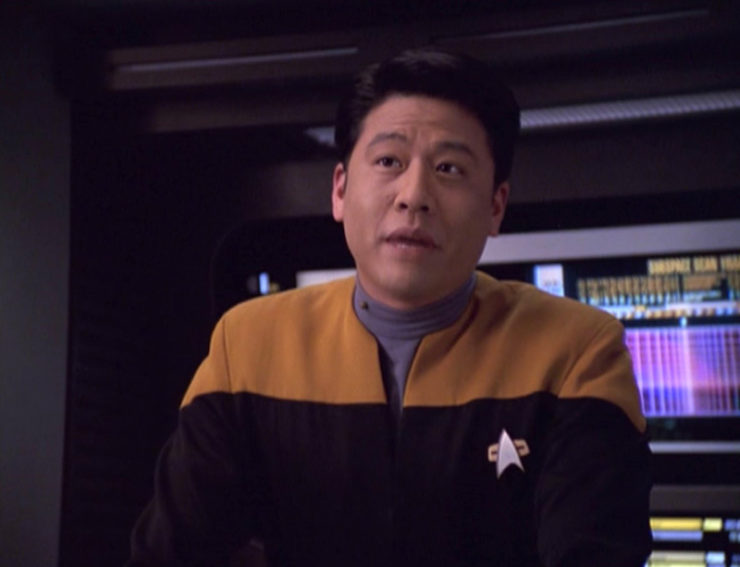
Please state the nature of the medical emergency. The EMH tries to reassure Seven that dreaming is normal and is incredibly dubious about this latest use of Vulcan telepathy.
Resistance is futile. Seven apparently spent her regenerating time when she was a drone going to Unimatrix Zero and having hot monkey sex with Axum. She doesn’t entirely remember this, and is pissy when she realizes that Axum didn’t come out and mention that from jump when she showed back up.
She also can appear completely human in the forest, and after the second time she arrives, does so.
No sex, please, we’re Starfleet. Paris threatens to sabotage the Flyer to keep Torres from going on the mission. He’s incredibly unhappy about his woobie going on this mission…
Do it.
“It’s a shame you’re not alive to experience disembodiment. It’s the epitome of perfection.”
–The Borg Queen waxing rhapsodic about decapitation.
Welcome aboard. Susanna Thompson is back as the Borg Queen, following “Dark Frontier.” Mark Deakins plays Axum/Five of Twelve, having previously played Turanj in “The Killing Game” two-parter and Tournel in Insurrection. Jerome Butler plays Korok, Joanna Heimbold plays Laura, and Ryan Sparks plays the alien boy. They’ll all be back for Part II.
Also Tony Sears plays the drone the queen deactivates in the teaser. He previously played an ill-fated Prometheus crew member in “Message in a Bottle.”
Trivial matters: The Battle of Wolf 359 happened in TNG’s “The Best of Both Worlds, Part II,” and was seen in part in DS9’s “Emissary.” As with other Alpha Quadrant folks who we’re told were assimilated at Wolf 359 (“Unity,” “Infinite Regress“), it’s not clear how someone assimilated in that battle could possibly have wound up in the Delta Quadrant, given that the Cube that fought that battle was destroyed over Earth.
Mike Sussman’s original story pitch was that Seven’s father, Magnus Hansen—seen as a drone in “Dark Frontier”—had started a Borg underground resistance.
The Borg Queen knows that Voyager has had contact with Starfleet, referring to the events of “Message in a Bottle,” “Hunters,” “Pathfinder,” and “Life Line.”
Paris was demoted to ensign in “Thirty Days.”
Janeway says that the last time she heard the words, “My mind to your mind,” she had a headache for two weeks. It is possible she’s referring to her deep mind-meld with Tuvok in “Flashback.”
The Delta Flyer joins a large number of Voyager’s shuttlecraft in Support Vessel Heaven, as it’s destroyed. A new one will be constructed in “Imperfection” next season.
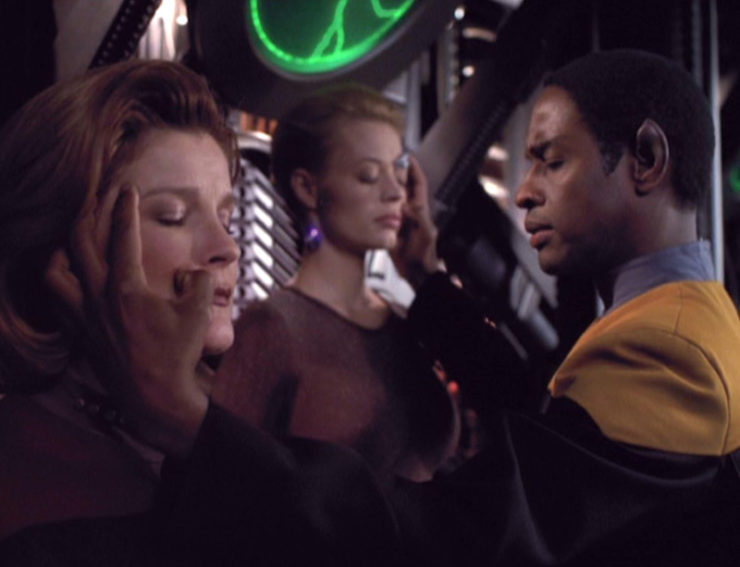
Set a course for home. “How are things in the collective?” In much the same way that, over time, the producers of DS9 took everything that was interesting and alien about the beings who lived in the Bajoran wormhole and made them trite and boring, so too with Voyager’s producers and the Borg. The “ultimate user” species that Q described as utterly uninterested in the nuances of human behavior or communication but only was interested in technology they can consume has turned instead into a mustache-twirling villain who taunts her arch-nemesis and gives monologues and isn’t actually dangerous to attack.
There’s no sense of menace here. The Borg Queen, introduced as a haunting, scary ghost in the machine in First Contact, has turned into an ineffectual villain helplessly trying to keep her drones under control and stymied by the machinations of Janeway and her crew. Susanna Thompson does the best she can, but the script does her no favors, stopping just barely short of having her shake her fist and saying, “Curses, foiled again!”
These are the same Borg who wiped out forty ships at Wolf 359, who almost destroyed the Federation before it started, and yet somehow this one stranded Federation starship can run rings around them, and it cuts off the air supply to my disbelief.
Which is too bad, as the basic concept here is a good one. I like the Unimatrix Zero setting a lot, as it provides a way to foment a Borg resistance in a way that’s convincing. But it’s in service of an episode that just sits there, lifelessly. Paris’s promotion makes no sense, made more absurd by Kim still being an ensign, an absurdity the script comes right out and admits to. Janeway asking for Chakotay’s support is a nice touch, especially in light of her running over her first officer in the “Equinox” two-parter, but Torres’ sudden willingness to go on a likely suicide mission comes out of nowhere.
And the ending is utterly ineffective. Picard being made into a Borg was devastating in 1990, but a decade later, it’s hard to work up any excitement over the same being done to Janeway, Tuvok, and Torres, especially given the sheer tonnage of Borg reversals we’ve seen in those ten years (the folks in “Unity,” Seven, the Borg kiddos—and speaking of them, what a blown opportunity to not have Icheb, Mezoti, Azan, and Rebi be part of this storyline!).
Worse, Chakotay acts like he expects them to be assimilated, which means it’s bizarrely all part of the plan (as we’ll see in Part II), which drains what miniscule excitement there is from the cliffhanger.
Warp factor rating: 4
Keith R.A. DeCandido‘s recent and upcoming work includes the thriller Animal, written with Dr. Munish K. Batra; the novella All-the-Way House, part of the Systema Paradoxa series about cryptids; the short story “Unguarded” in the forthcoming Devilish and Divine anthology; essays for two upcoming anthologies, BIFF! BAM! EEE-YOW!: The Subterranean Blue Grotto Essays on Batman ’66 and Outside In Wants to Believe: 158 Unique Perspectives on 158 Ten Thirteen Stories by 158 Authors; the short story “In Earth and Sky and Sea Strange Things There Be” in the charity anthology Turning the Tied; and a reprint of his 2005 Spider-Man novel Down These Mean Streets in the collection Spider-Man: The Darkest Hours Omnibus, alongside Spidey novels by Jim Butcher and Christopher L. Bennett.










